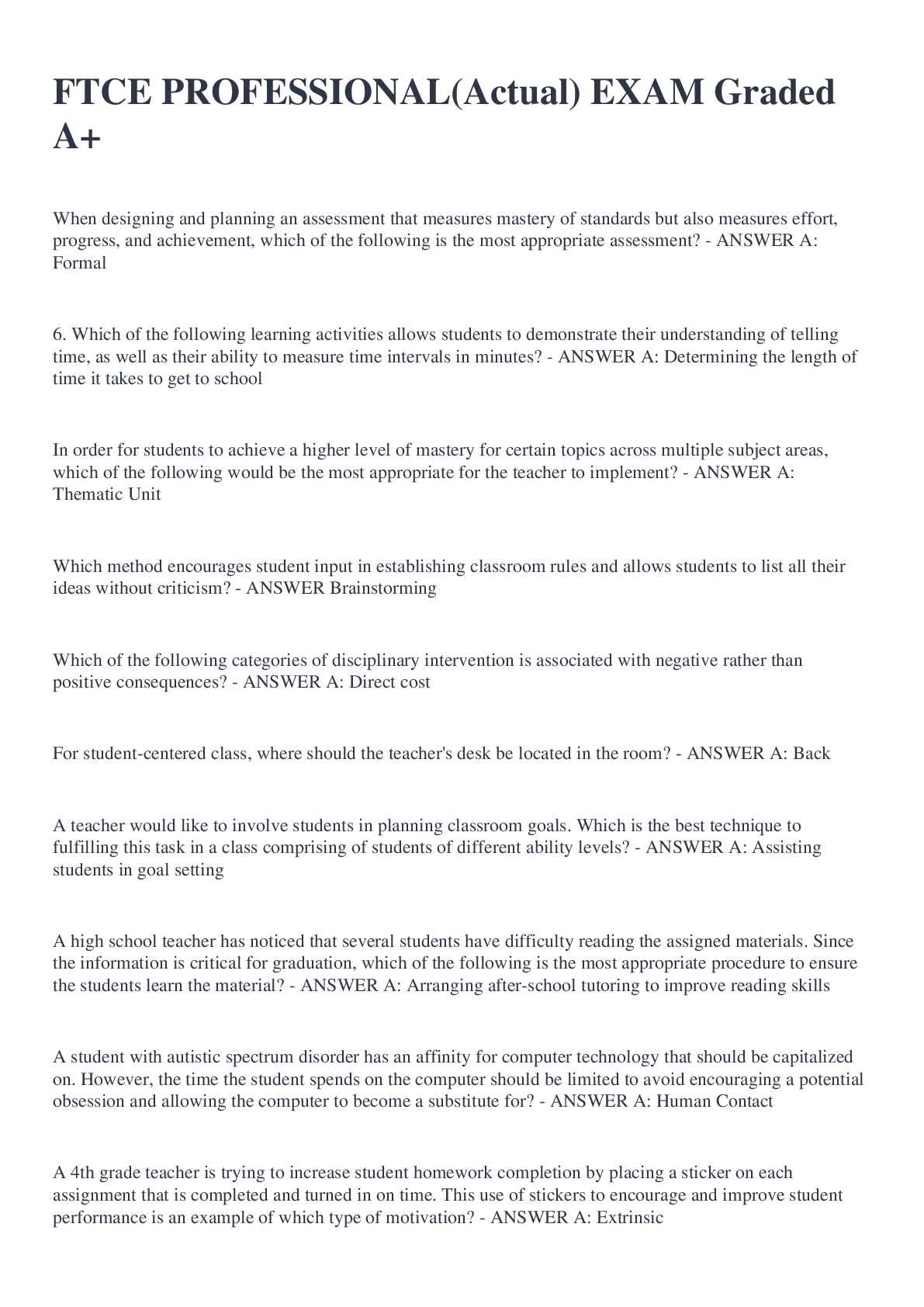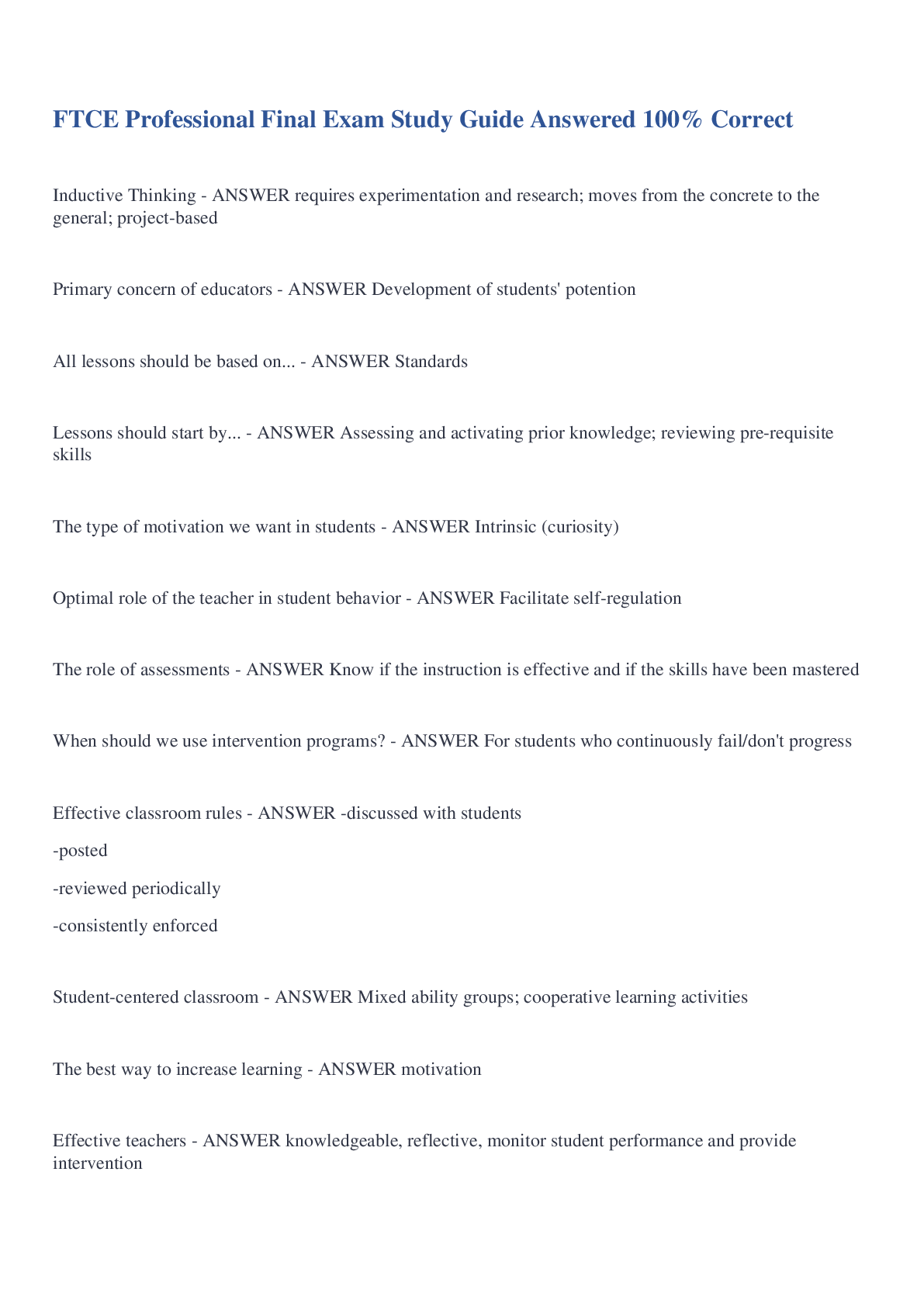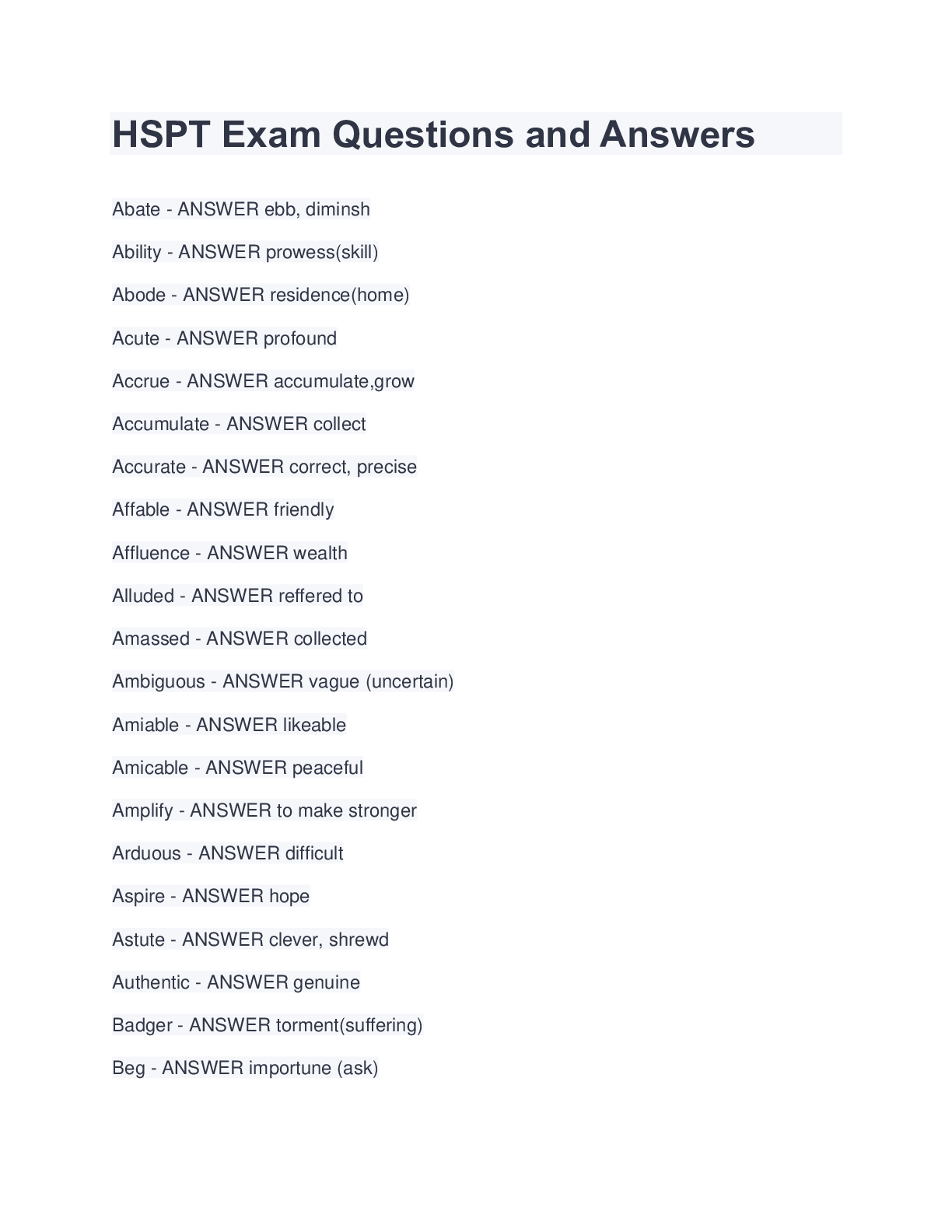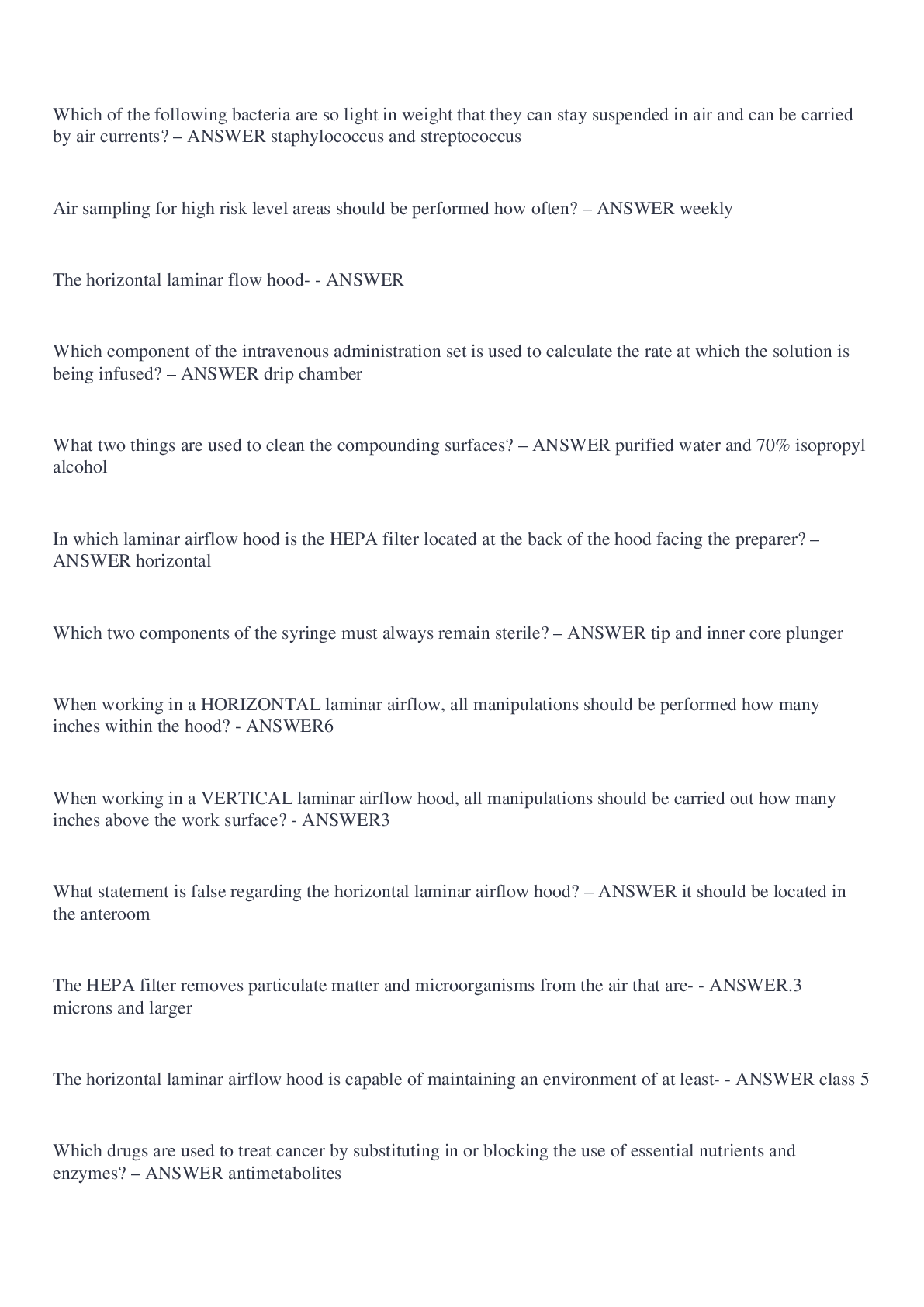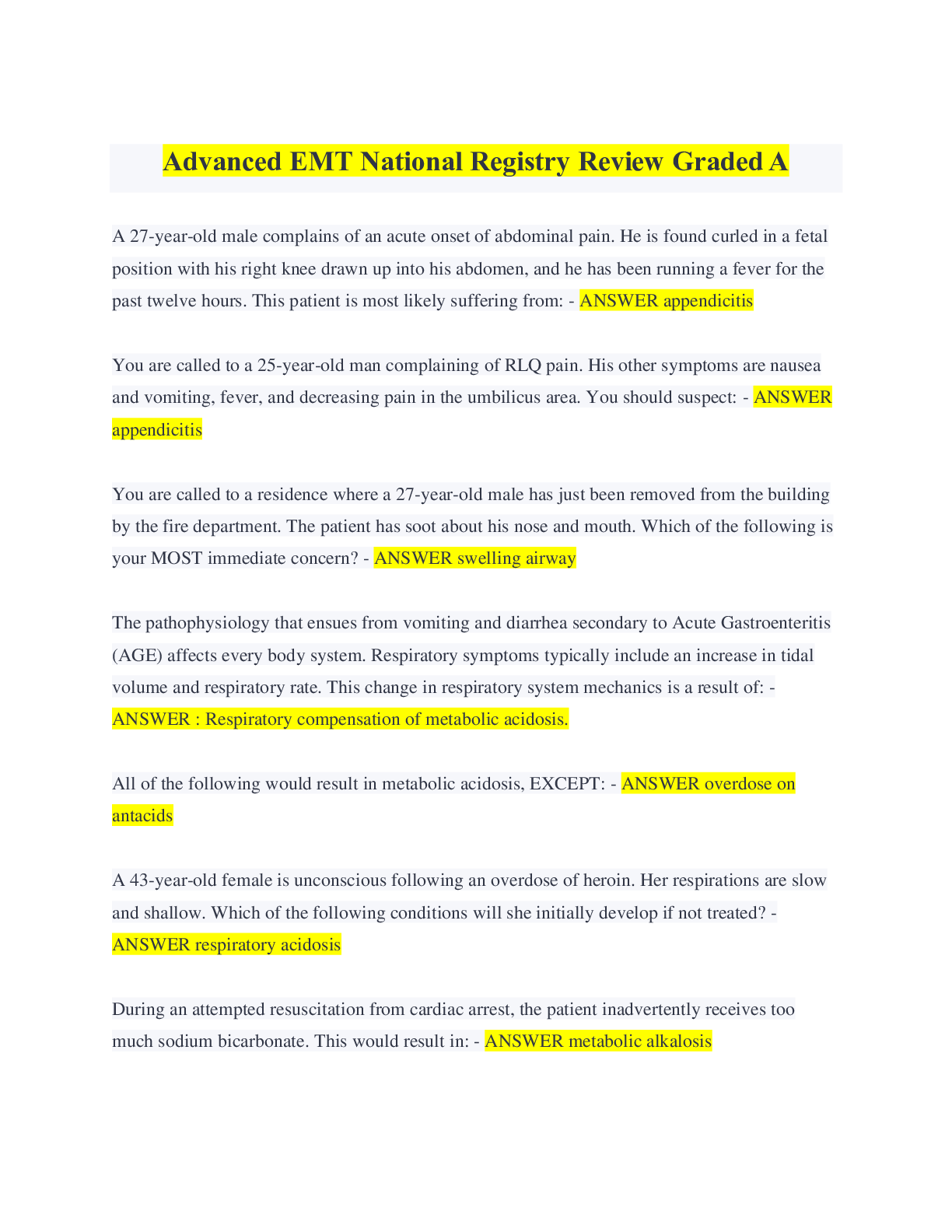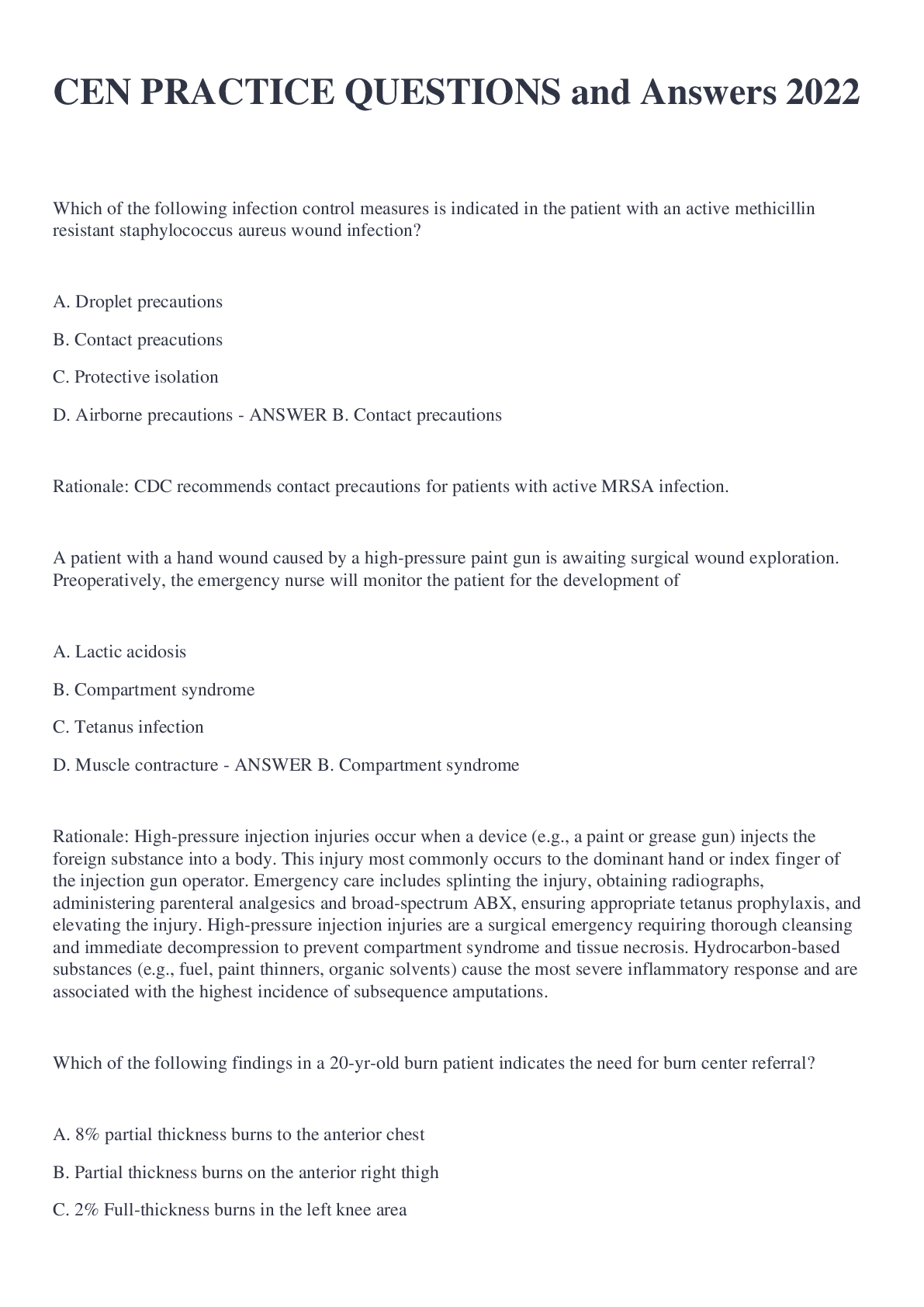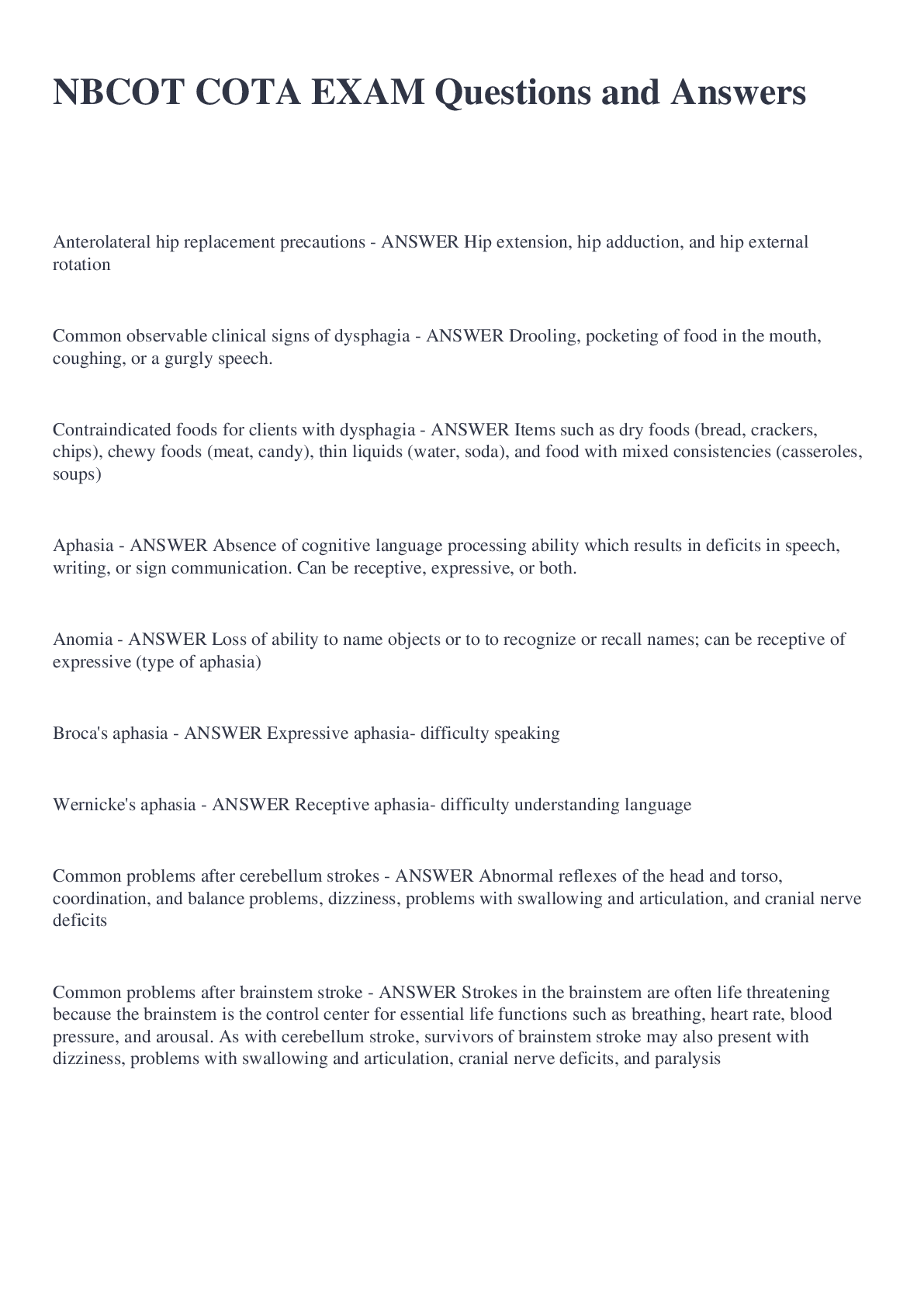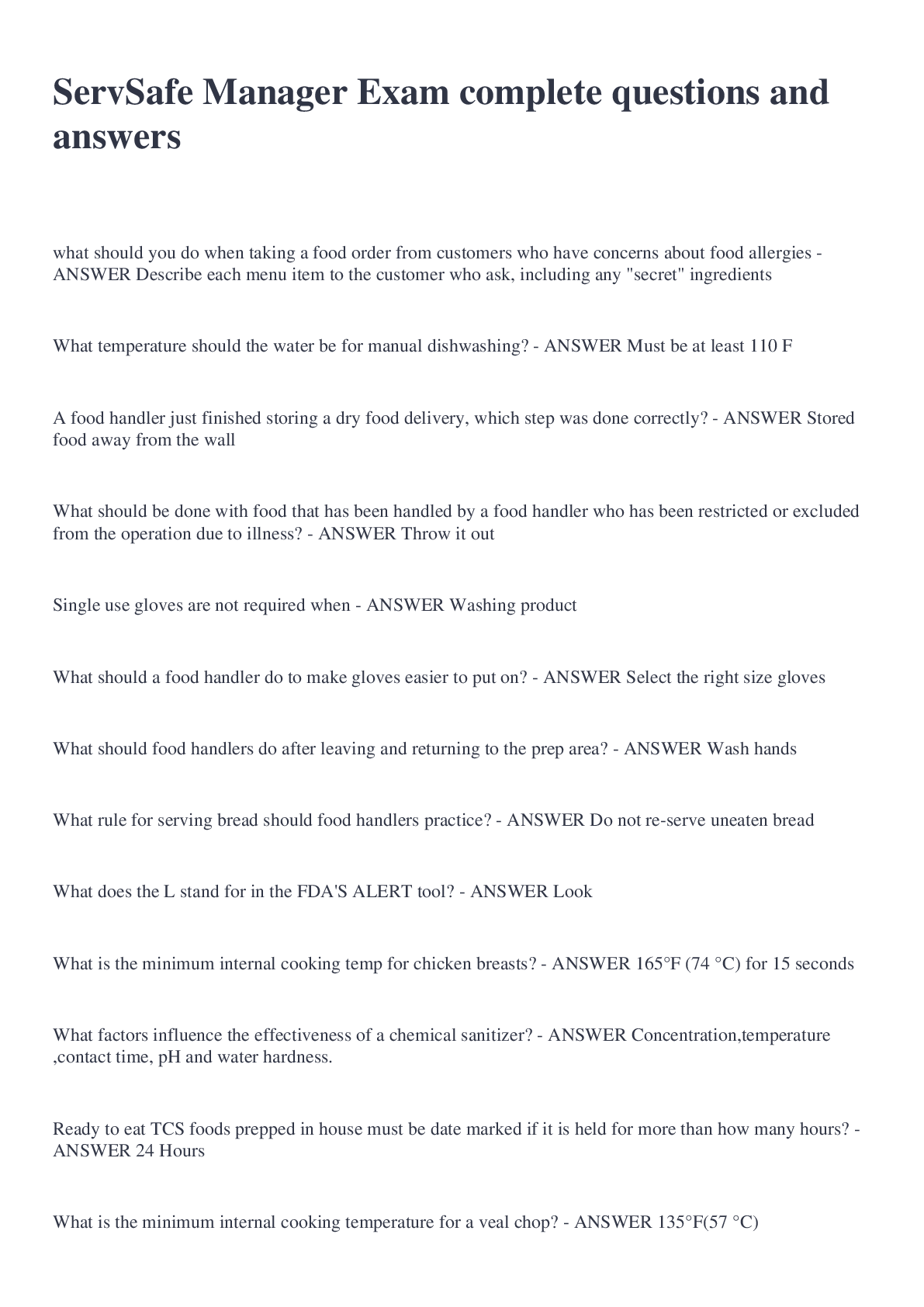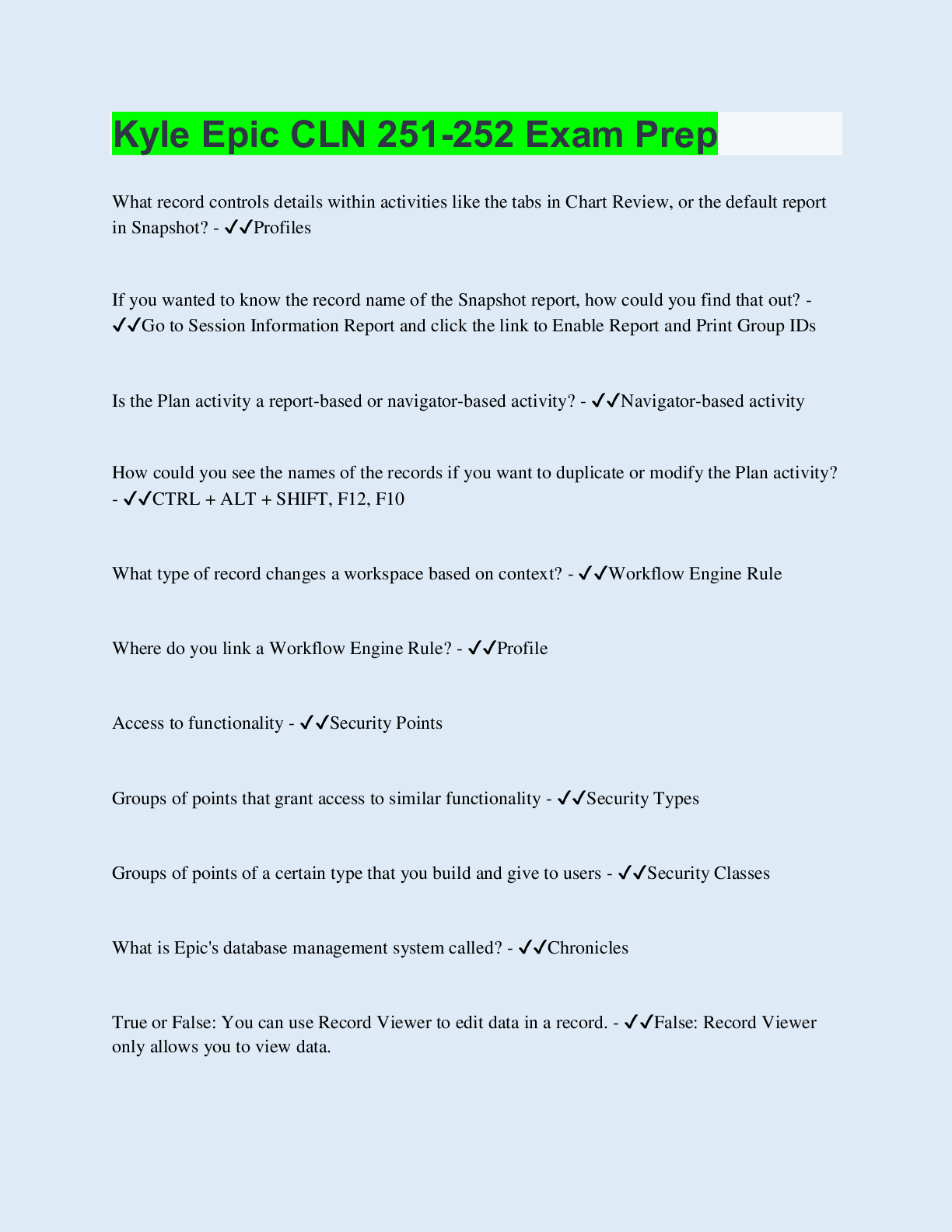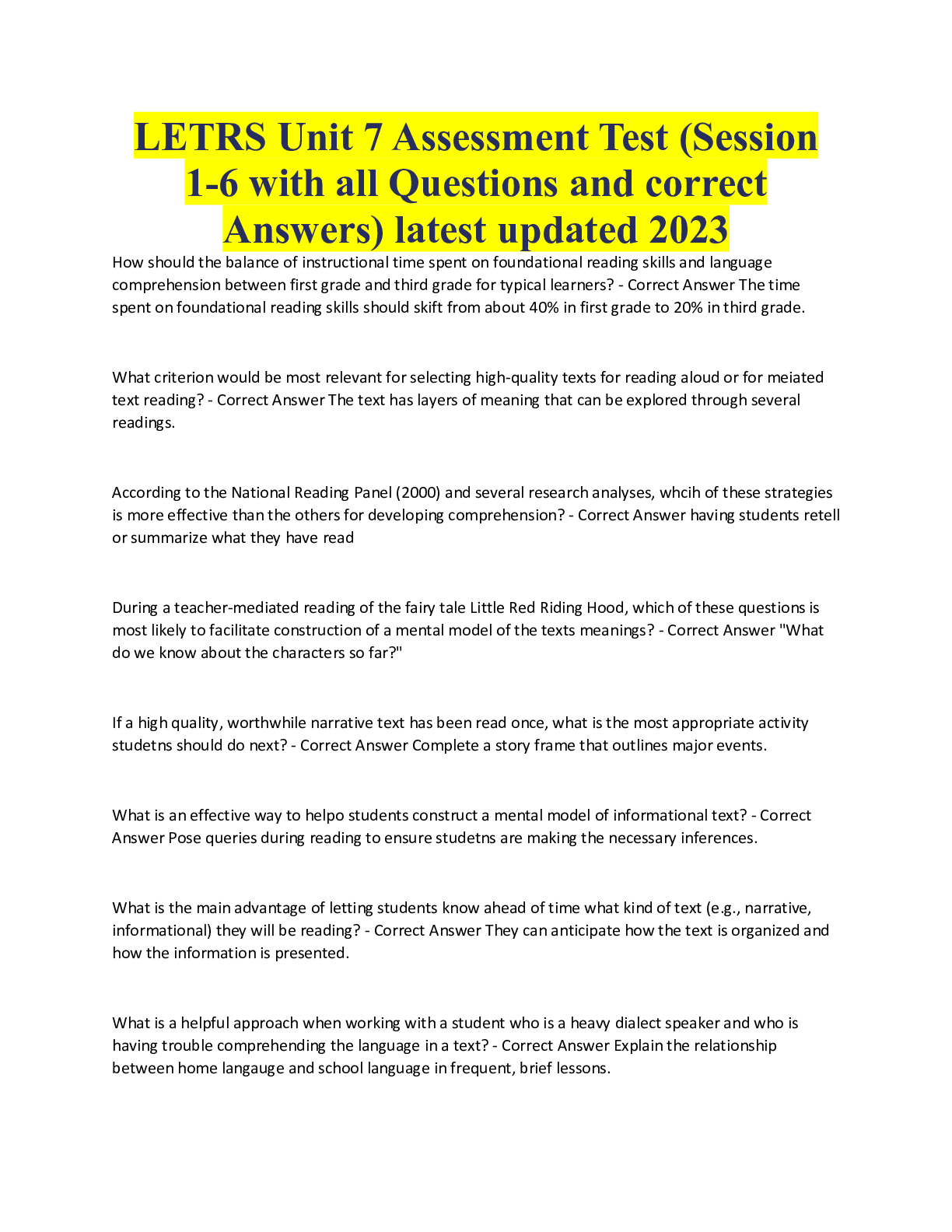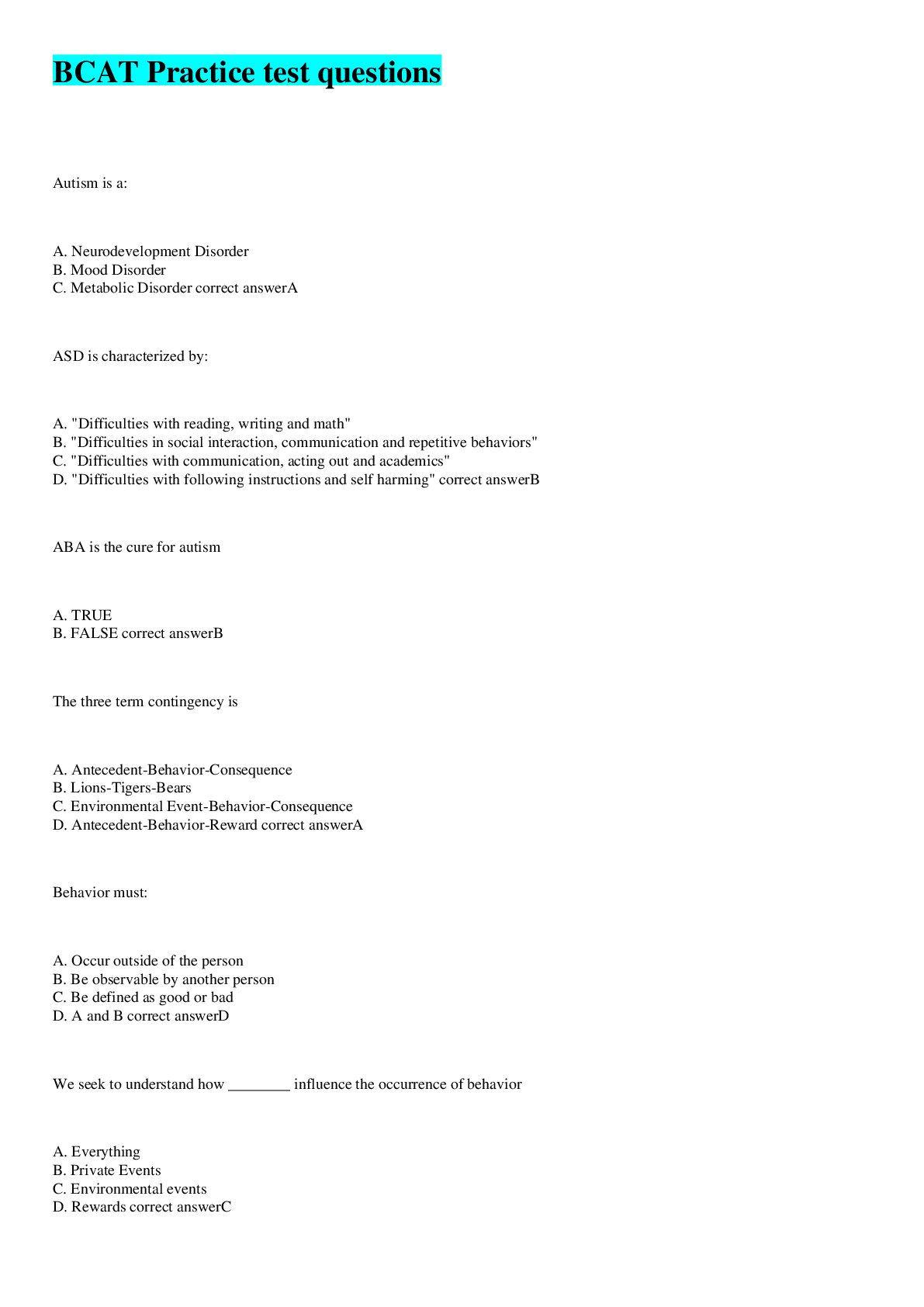Social Sciences > EXAM > LMSW Practice Test Questions (Answered 100%) (All)
LMSW Practice Test Questions (Answered 100%)
Document Content and Description Below
1. According to Beck, a depressed person does not see the positive aspects of his/her situation because of: a. Precipitating factors b. Lack of support c. A dysfunctional schema d. Lack of adap... tive coping strategies - ANSWER c. A dysfunctional schema 2. It is necessary to obtain informed consent prior to giving out data about a patient. Which of the following statements is MOST correct regarding this issue? a. You must obtain informed consent from your patient in most situations, but not in all situations. b. If a significant other requests information about your patient, you may release it without informed consent. c. If you are going to consult with a colleague, you must have informed consent from your patient. d. You must always have informed consent from your patient. - ANSWER a. You must obtain informed consent from your patient in most situations, but not in all situations. 3. A soldier with combat-related Posttraumatic Stress Disorder desires to return to combat. What is the first thing you should do? a. Allow the soldier full self-determination, returning when he deems appropriate. b. Inform the client that return will likely cause an increase in symptoms and is not advised. c. Contact the commanding officer to determine if this is an option for the soldier. d. Assess progress in treatment and current level of functioning. - ANSWER d. Assess progress in treatment and current level of functioning. 4. A man is referred by his primary care provider and presents with a diagnosis of Hypochondriasis. What is the FIRST crucial step in treatment? a. History taking b. Establishment of trust and appreciation for the patient's problems c. Education about the link between stress, emotions and lifestyle and physical health d. Treatment planning - ANSWER b. Establishment of trust and appreciation for the patient's problems 5. Client: "I'm depressed. I've lost my hair at a much quicker rate than I thought possible. I'm terribly embarrassed to go out in public. I'm feeling extremely anxious and uneasy about my baldness." Social Worker: "You're anxious and uneasy about the transformations that are a natural process of aging." The social worker's response is: a. Encouragement b. Summarization c. Paraphrase d. Reflection of feeling - ANSWER d. Reflection of feeling 6. How do you find the median of a set with an even number of items? a. The larger of the two middle numbers is the median. b. The two middle numbers are both medians. c. Find the average of the two middle numbers. d. A set with an even number of items does not have a median. - ANSWER c. Find the average of the two middle numbers. 7. A young, beginning social worker has some intrapersonal and interpersonal struggles with women in authority positions that stem from her poor relationship with her mother. The social worker's client is a female 50-ish successful CEO of an Internet start-up. The social worker is likely to struggle in therapy due to: a. Counter-resistance b. Counter-transference c. Transference d. Resistance - ANSWER b. Counter-transference 8. When treating elder adults with depression, the BEST approach to treatment is: a. Cognitive behavioral therapy coupled with family interventions. b. Significant reliance on psychiatry because medication management is most important. c. Treatment of elder adults is similar to other adults, so no significant alterations are needed. d. Coordination between medical and mental health due to the influence of medical conditions on psychiatric symptomatology. - ANSWER d. Coordination between medical and mental health due to the influence of medical conditions on psychiatric symptomatology. 9. Professional ethics and professional values differ in which of the following: a. Values are a subset of ethics. b. Values deal with what is right or wrong in practice, and ethics deals with the principles of practice. c. Values and ethics are basically the same and are evaluated based on the specific situation. d. When a social worker makes a judgment that is ethical, you can assume it is a judgment that also upholds professional values. - ANSWER b. Values deal with what is right or wrong in practice, and ethics deals with the principles of practice. 10. What is the first thing to assess in on-site basic crisis intervention, such as in the aftermath of a natural disaster? a. Immediate needs for physical safety, food and clothing b. Trauma response c. Future mental health risk d. Needs for various concrete services (e.g., transportation, alternate housing) - ANSWER a. Immediate needs for physical safety, food and clothing 7-year-old child is refusing to sleep in his own bed at night. When the parents sit with him in his room, he is fine. When they leave the room, he begins to cry. When they come back in, he stops crying. This is an example of Operant conditioning Classical conditioning Punishment cycles Higher order conditioning - ANSWER operant conditioning Older individuals are often misdiagnosed with Alzheimer's when, in fact, the more accurate diagnosis is Anxiety Depression Thyroid Disorder Delirium - ANSWER Depression. Approximately 55% of the elderly suffer from depression and are often misdiagnosed with Alzheimer's or Dementia. Anxiety (answer #1) is not correct, although anxiety can be a problem in older adults; anxiety is not a characteristic that would be a symptom of Alzheimer's. Thyroid disorder (answer #3) is not correct because this condition is a malfunction of the thyroid gland, resulting in a variety of medical symptoms, usually not similar to symptoms of Alzheimer's. Delirium (answer #4) is not correct, as Delirium is characterized by a disturbance of consciousness and a change in cognition that develop over a short period of time. A social worker is seeing a new client, who is a college student, for therapy. After speaking with the client about her current enrollment at the university, the social worker spent a significant amount of time urging the client to work less so she could focus on school. The social worker wants the client to get all "A" grades this semester because she reminds him of his daughter at that same stage in life, as well as the anxieties that he experienced during that time in his life. The client really wants to please the social worker because he reminds her of her dad. Which of the following is reflected in the client? Transference Counter-transference Projection A dual relationship - ANSWER Tranference. In a therapeutic context, transference refers to redirection of a client's feelings from a significant person to the social worker. Counter-transference (answer #2) is incorrect because this is the redirection of a social worker's feelings toward a client, or more generally speaking a social worker's emotional entanglement with a client, which was reflected in the first part of the question; however, this does not describe what is being reflected in this client. Projection (answer #3) is demonstrated when a person's own unacceptable or threatening feelings are repressed and then attributed to someone else, which is not occurring in this case example. A dual relationship (answer #4) is incorrect, as this refers to a situation where multiple roles exist (not just perceived) between a social worker and a client, such as an actual father and daughter relationship between a social worker and client. A client was recently diagnosed with Multiple Sclerosis. She immediately began to learn everything she could about the illness: reading books, journal articles, and the latest experimental research. The client's response to her diagnosis is representative of which defense mechanism? Intellectualization Regression Sublimation Repression - ANSWER Intellectualization A social worker has been working with a 35-year-old divorced woman who has joint custody of her son, but is the custodial parent. Her ex-husband, whom the social worker has never met, is taking the client to court in an attempt to gain full custody of the son. The social worker receives a subpoena from the husband's attorney requesting records regarding the wife's therapy sessions with the social worker. The social worker is required to do which of the following? The social worker must release the entire record of the therapy sessions to the attorney The social worker is allowed to release only those records that make direct reference to the wife's relationship with the son, not her treatment issues The social worker is required to respond to the subpoena, but is not required to release records since the subpoena was issued by the attorney and not a judge The social worker does not have to respond to the subpoena because the client's records are confidential - ANSWER The social worker is required to respond to the subpoena, but is not required to release records since the subpoena was issued by the attorney and not a judge A 22-year-old female client is considering having an abortion. Her social worker is pro-choice and feels passionately about the issue. Which of the following is the FIRST thing that the social worker should do in this situation? She should talk with the client about abortion alternatives She should refer the client to another social worker She should help the client obtain the services she needs to get an abortion She should ask the client to share her rationale for choosing abortion - ANSWER The correct answer is #4 - She should ask the client to share her rationale for choosing abortion. Keep in mind that a social worker should always seek to understand. Talking with the client about abortion alternatives (answer #1) and referring the client to another social worker (answer #2) are both not correct because once the client has provided more information, the social worker can ascertain if the client lacks information about other options or needs to be referred to another social worker. Helping the client obtain the services she needs to get an abortion (answer #3) is not correct because if the social worker helps the client obtain abortion services, she may miss an important opportunity to gain further understanding of the client's circumstances and alternatives. Remember, the question asks for the FIRST thing the social worker should do in this situation. A teacher has noticed some dramatic behavioral changes in a 7-year-old boy over the recent weeks and has referred him to the school social worker. The child appears distracted in class, no longer finishes his daily assignments, has become aggressive toward peers, has soiled his pants on two occasions, and appears apprehensive around adults. Which of the following might likely be the cause of this child's behaviors? Possible neglect at home Possible sexual abuse Onset of Conduct Disorder Recent death of a loved one - ANSWER Possible sexual abuse A 30-year-old gay male is seeking treatment in a mental health agency. The intake social worker begins to gather information to determine this individual's qualification for services. The client states that he has been feeling sad and hopeless, and is losing interest in activities in which he used to participate. He states that he and his partner have recently broken up and that he has been spending less time with his parents and siblings. The intake worker should refer this individual for treatment and identify his presenting problem as His Homosexuality Relationship issues Family issues Depression - ANSWER Depression A client asks the social worker to view his therapy records. The social worker knows that showing the records to the client will be harmful given the client's profile. What is the social workers ethical responsibility? The social worker should show the client his or her records as the client has the right to view them The social worker should limit the client's access to his records and provide assistance in interpreting the records shown to the client The social worker should deny the client access and explain the reasons for doing so The social worker should consult with a colleague - ANSWER The social worker should limit the client's access to his records and provide assistance in interpreting the records shown to the client A politician recently admitted his arrangement with the pharmaceutical industry, which involved writing key legislation to mandate vaccinations if the industry would, in return, finance the majority of his re-election campaign. According to Kohlberg's Theory of Moral Development, at which level of moral development was the politician operating? Pre-conventional Morality Conventional Morality Post-Conventional Morality Morality of Social Contract - ANSWER The correct answer is #1 - Pre-conventional Morality. Pre-conventional Morality is Level 1, Stage 2 and involves "you scratch my back and I'll scratch your back" types of behavior. Conventional Morality (answer #2) and Post-Conventional Morality (answer #3) are both incorrect, as they are both identified as levels involving moral reasoning that goes beyond a self-focused perspective. Morality of Social Contract (answer #4) is not correct because it is a stage, not a level, according to Kohlberg. Moreover, it involves higher moral reasoning than that demonstrated by the politician. A client has been drinking frequently since the death of his son last year. He states that he feels better physically when he drinks more, especially in the mid-morning, and that he does not feel intoxicated as often [Show More]
Last updated: 2 years ago
Preview 1 out of 36 pages
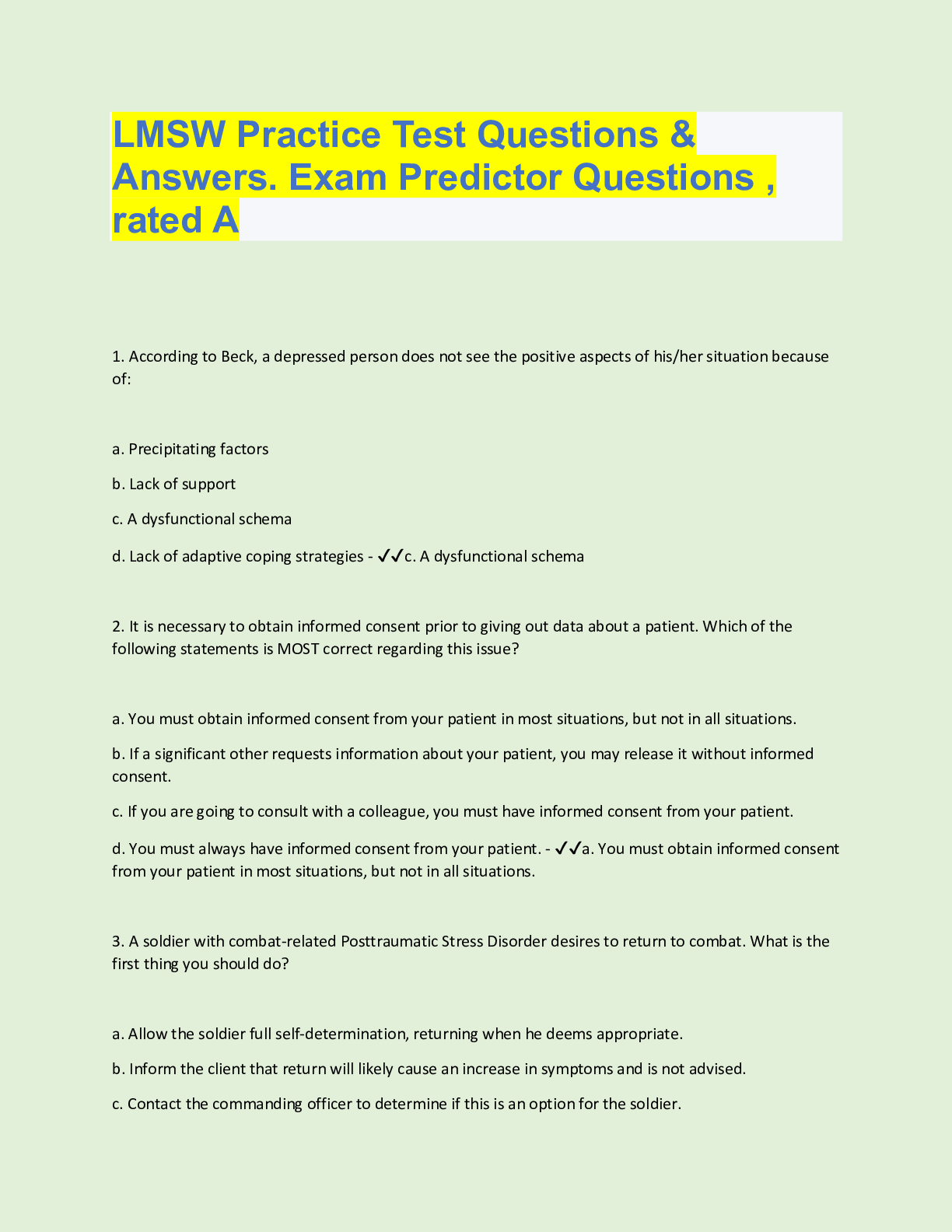
Buy this document to get the full access instantly
Instant Download Access after purchase
Buy NowInstant download
We Accept:

Reviews( 0 )
$9.00
Can't find what you want? Try our AI powered Search
Document information
Connected school, study & course
About the document
Uploaded On
Sep 07, 2022
Number of pages
36
Written in
Additional information
This document has been written for:
Uploaded
Sep 07, 2022
Downloads
0
Views
53

